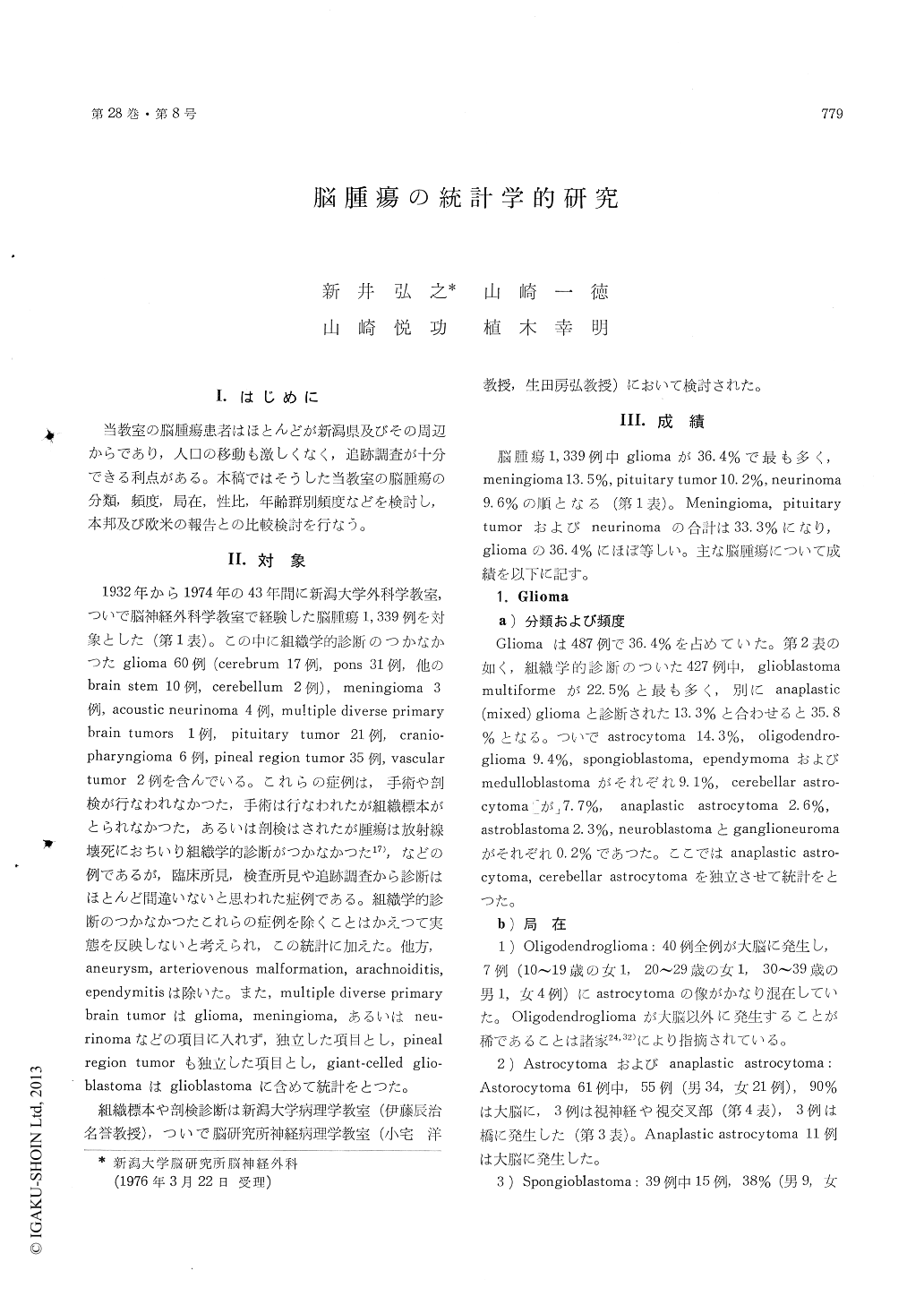Japanese
English
- 有料閲覧
- Abstract 文献概要
- 1ページ目 Look Inside
I.はじめに
当教室の脳腫瘍患者はほとんどが新潟県及びその周辺からであり,人口の移動も激しくなく,追跡調査が十分できる利点がある。本稿ではそうした当教室の脳腫瘍の分類,頻度,局在,性比,年齢群別頻度などを検討し,本邦及び欧米の報告との比較検討を行なう。
During the last 43 years, from 1932 through 1974, 1,339 cases of brain tumors were observed at the Department of Neurosurgery in Niigata Uni-versity Hospital (Table 1). Aneurysms, arterio-venous malformations, arachnoiditis and ependymitis were excluded from the present series. On the other hand, these 1,339 cases included 132 cases of histologically unverified brain tumors, such as 60 gliomas, 3 meningiomas, 4 acoustic neurinomas, 1 multiple diverse primary brain tumor, 21 pituitary tumors, 6 craniopharyngiomas, 35 pineal region tumors and 2 vascular tumors, because the histo-logical pictures of these tumors were very probable from the clinical and physical findings (Table 1). Frequency, localization, male: female ratio, frequen-cies in decennial age groups were analyzed statisti-cally (Tables 1 to 13).
Of the 1,339 brain tumors, 36.4% were gliomas, 13.5% were meningiomas, 10.2% were pituitary tumors, and 9.6% were neurinomas. There was a slight preponderance of males over females (752: 587, or approximately 1.28:1). Certain brain tumors showed notable differences in sex. The preponderance of males was as follows: pineal region tumors 4.0:1, hemangioblastomas 3.3:1, granulomas and abscess 2.6:1, sarcomas 2.2:1, gliomas 1.44:1, pituitary tumors 1.4:1, and craniopharyngiomas 1.3:1. The preponderance of females was: meningiomas 1.5:1, and neurinomas 1.2:1. Although pineal region tumors, gliomas and pituitary tumors were found to be more frequent in males in general, ectopic pinealomas, pituitary mixed adenomas and cerebellar astro-cytomas were revealed to predominate in females with the ratio of 12:1,1.6:1 and 1.2:1 re-spectively. Pineal region tumors and hemangio-blastomas were found significantly more frequent in males. The preponderance of meningiomas and neurinomas in females was also found to be signifi-cant.
Our series were compared with other series re-ported in Japan and in other countries in which aneurysms, arteriovenous malformations, arach-noiditis and ependymitis were excluded from the brain tumors (Table 14). Pineal region tumors and gliomas were more frequent, and pituitary tumors and congenital tumors were less frequent in our series than in other series in Japan. Pineal region tumors, neurinomas, congenital tumors, cranio-pharyngiomas and pituitary tumors were more frequent, and gliomas and meningiomas were less frequent in our series than in other series reported in the United States and Europe. Incidence of pineal region tumors in our series (7.5%) was markedly high.

Copyright © 1976, Igaku-Shoin Ltd. All rights reserved.


